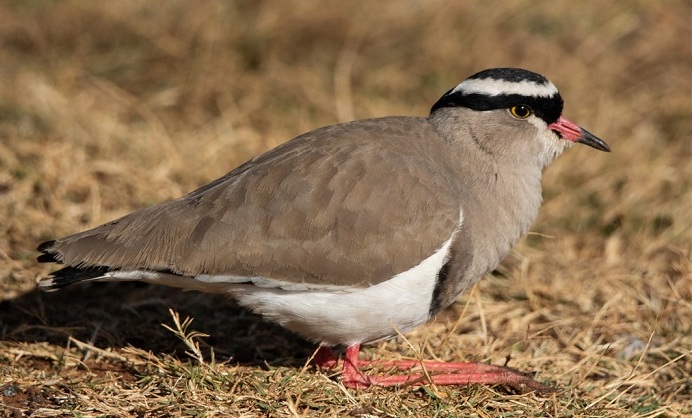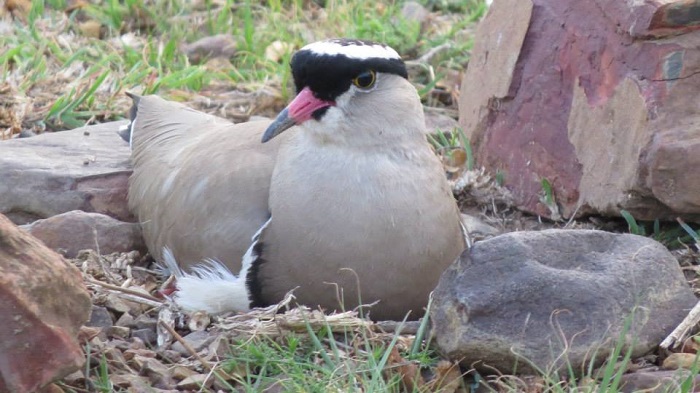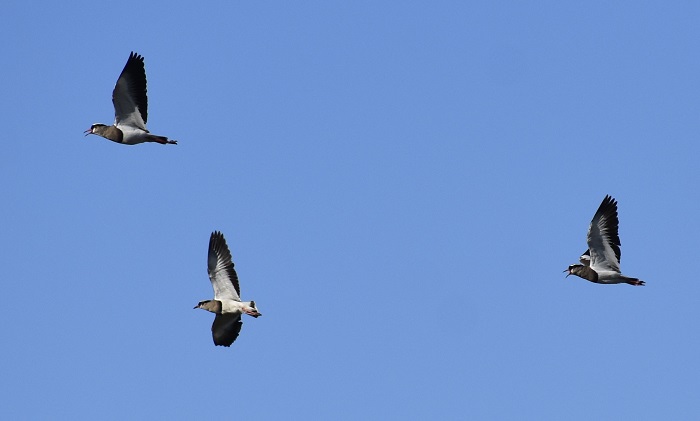Cover image of Crowned Lapwing by Pieter Cronje – Moreleta Kloof Nature Reserve, Gauteng – BirdPix No. 89394
Identification
The Crowned Lapwing is a distinctively marked and conspicuous species. The black and white banded plumage on the head is diagnostic. The upperparts, neck and breast are plain sandy-brown. The belly, vent and undertail coverts are white, while the breast and belly are separated by a black band. The legs are bright pinkish red and the bill is red with a black tip.

Photo by Gerald Wingate
In flight the primaries are black and contrast strongly with the white primary coverts and brown back.
The sexes are alike. Juveniles resemble the adults but have scalloped upperparts, buffy barring on the crown and yellowish, not red legs.

Mkhuze Game Reserve, KwaZulu-Natal
Photo by Colin Summersgill
Status and Distribution
The Crowned Lapwing is considered a common to very common resident and local migrant.
The distribution stretches from Ethiopia and Somalia south through East Africa to southern Angola and South Africa. It is found throughout southern Africa, but is mostly absent from the arid south-west of Namibia, and is scarce in the western parts of the Northern Cape, Lesotho, the former Transkei (Eastern Cape) and parts of southern Mozambique.

The core of its range lies in Botswana, North West Province, Gauteng and Free State, as well as the agricultural lands of the Western Cape.
The Crowned Lapwing is not threatened and has expanded its range as a result of human activities such as bush-clearing, overgrazing and allowing fields to lie fallow.
Habitat

Pilanesberg National Park, North West
Photo by Phillip Nieuwoudt
Crowned Lapwings inhabit dry, open grassland, sparse woodland and open areas in Karoo scrub, favouring sites with short grass. It has adapted well to man-modified habitats, including short pastures, open fields, airports, golf courses, sports fields and roadsides. It is frequently attracted to burnt grasslands and normally avoids areas of tall grass. The Crowned Lapwing is not generally associated with water, but occurs in dry salt-marsh vegetation and around pans and usually avoids mountainous areas.
Behaviour

Photo by Lia Steen
The Crowned Lapwing is typically encountered in loose flocks of varying sizes but is found in pairs during the breeding season.
It is mostly a dry season visitor to regions of higher rainfall but it can remain year-round in dry years. It frequently undertakes local movements but neither the scale nor regularity of these movements is understood.
When feeling threatened, Crowned Lapwings will call whilst bobbing the body up and down. They stand in a hunched posture or sit on the ground when not foraging. Bathes by standing in water up to breast and using the wings to flap and splash water onto the body. Crowned Lapwings roost on the ground, usually in slightly elevated places.

Photo by Neels Jackson
Forages by standing or walking slowly, while scanning for potential prey and then dashing in to peck at it in typical plover fashion.
Foraging groups often move in a regularly spaced line. They feed primarily on harvester termites. Other prey taken includes ants, beetles and small numbers of grasshoppers, spiders and millipedes. Also consumes earthworms after heavy rain showers.
Frequently associates or forages with other Lapwing species, most notably the Black-winged Lapwing (Vanellus melanopterus). The two species show few aggressive interactions and sometimes defend feeding territories together. This association is mutualistic in that both species benefit from from the interaction. The larger and more aggressive Crowned Lapwing helps to defend the less aggressive Black-winged Lapwing. The Black-winged Lapwing is the more alert and vigilant of the two and this allows the Crowned Lapwing to spend more time feeding.

Photo by Phillip Nieuwoudt
Crowned Lapwings become largely inactive when temperatures rise above 24°C or fall below 10°C.
They are monogamous and only rarely polygynous. Crowned Lapwings are territorial and solitary nesters, but often breed in small, loose aggregations. Breeding in groups provides an advantage against predators through group mobbing and safety in numbers. Males defend small territories which they acquire by calling continuously from an elevated position and also during circular display flights around 50 m above the territory.

Photo by Lia Steen
The nest is a shallow scrape in the ground, lined with dried grass, roots, small stones and dried dung. Nests are often situated among large stones in order to disguise the shape of the incubating bird. The nest site is usually located within 10-20 m of shade, and is frequently reused in successive years.
Egg laying can occur at any time of the year with a peak from August to December, but is slightly earlier in the winter-rainfall regions of the Western Cape. The female lays 2 to 4 eggs per clutch. The eggs are yellowish-brown to olive-brown, boldly spotted with black and grey. The female usually lays a replacement clutch if the previous clutch fails and up to 6 clutches may be laid in a single season.
Incubation begins after the full clutch has been laid in cool conditions but starts after the first-laid egg during hot conditions. The incubation period lasts for around 30 days and the female is responsible for most of the incubation duties. Pairs will aggressively defend the nest site from threats including terrestrial and aerial predators as well as large herbivores that could trample the nest. Nest defence also includes false-brooding and other distraction displays to lure terrestrial predators away from the nest. The intensity of their nest defence grows as incubation progresses.

Moreleta Kloof Nature Reserve, Gauteng
Photo by Pieter Cronje
Eggs hatch within a 4 to 6 hour period. The female removes broken eggshells, carrying them 20-30 m from the nest before breaking them up and discarding them. Newly hatched young are precocial and covered in down. They are speckled buff and black above with a black stripe down the back. Hatchlings remain at the nest for around 4 hours until their down has dried, after which they will then join and follow the parents. Chicks self-feed from their first day, but the adults still direct them to food items. The parents will defend the chicks vigorously through distraction displays and aerial mobbing, often almost striking intruders with trailing legs or wings.
The fledging period lasts for about 30 days but some chicks remain with the parents for almost a year, leaving before the start of the next breeding season. Fledglings from the first brood sometimes help with nest defence during the second breeding attempt.

Photo by Colin Summersgill
Further Resources
Species text from the first Southern African Bird Atlas Project (SABAP1), 1997.
The use of photographs by Colin Summersgill, Gerald Wingate, Karis Daniel, Lia Steen, Neels Jackson, Phillip Nieuwoudt and Pieter Cronje is acknowledged.
Virtual Museum (BirdPix > Search VM > By Scientific or Common Name).
Other common names: Kroonkiewiet (Afrikaans); iHoye (Zulu); lgxiya (Xhosa); Nghelekele (Tswana); Diadeemkievit (Dutch); Vanneau couronné (French); Kronenkiebitz (German); Abibe-coroado (Portuguese)
Recommended citation format: Tippett RM 2023. Crowned Lapwing Vanellus coronatus. Biodiversity and Development Institute. Available Online at http://thebdi.org/2023/07/07/crowned-lapwing-vanellus-coronatus/

Photo by Karis Daniel

